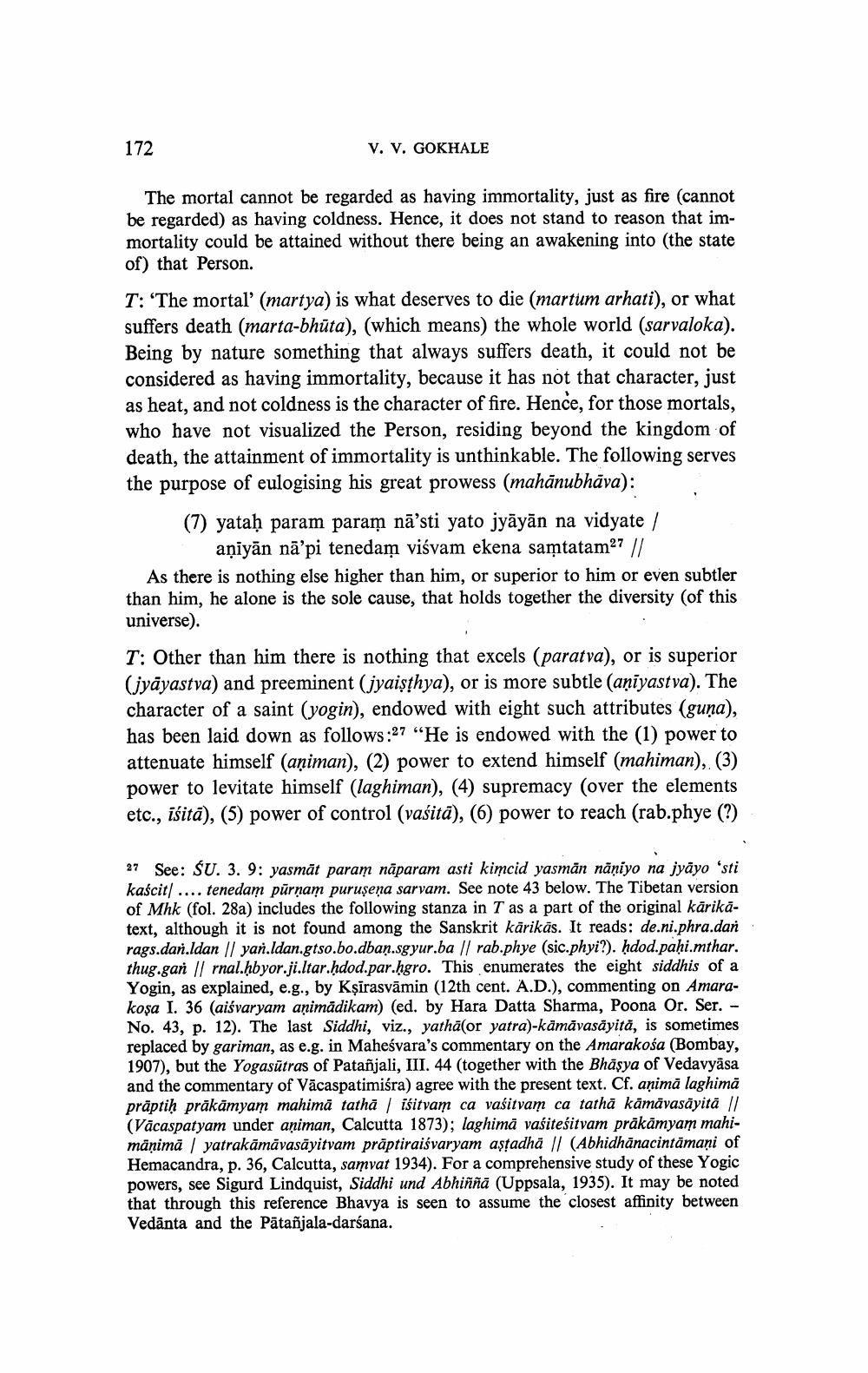________________
172
V. V. GOKHALE
The mortal cannot be regarded as having immortality, just as fire (cannot be regarded) as having coldness. Hence, it does not stand to reason that immortality could be attained without there being an awakening into the state of) that person.
T: 'The mortal' (martya) is what deserves to die (martum arhati), or what suffers death (marta-bhūta), (which means the whole world (sarvaloka). Being by nature something that always suffers death, it could not be considered as having immortality, because it has not that character, just as heat, and not coldness is the character of fire. Hence, for those mortals, who have not visualized the Person, residing beyond the kingdom of death, the attainment of immortality is unthinkable. The following serves the purpose of eulogising his great prowess (mahānubhāva):
(7) yataḥ param param nā'sti yato jyāyān na vidyate /
aņiyān nā'pi tenedam viśvam ekena samtatama7 || As there is nothing else higher than him, or superior to him or even subtler than him, he alone is the sole cause, that holds together the diversity of this universe). T: Other than him there is nothing that excels (paratva), or is superior (jyāyastva) and preeminent (jyaişthya), or is more subtle (aṇīyastva). The character of a saint (yogin), endowed with eight such attributes (guņa), has been laid down as follows:27 "He is endowed with the (1) power to attenuate himself (animan), (2) power to extend himself (mahiman), (3) power to levitate himself (laghiman), (4) supremacy (over the elements etc., išitā), (5) power of control (vašitā), (6) power to reach (rab.phye (?)
27 See: ŚU. 3. 9: yasmāt param nāparam asti kimcid yasmān nāņiyo na jyāyo 'sti kaścit) .... tenedam pūrņam puruşeņa sarvam. See note 43 below. The Tibetan version of Mhk (fol. 28a) includes the following stanza in T as a part of the original kārikātext, although it is not found among the Sanskrit kārikās. It reads: de.ni.phra.dan rags.dan.ldan || yan.ldan.gtso.bo.dban.sgyur.ba || rab.phye (sic.phyi?). ḥdod.pași.mthar. thug.gan // rnal.hbyor.ji.ltar.ḥdod.par.hgro. This enumerates the eight siddhis of a Yogin, as explained, e.g., by Kşirasvāmin (12th cent. A.D.), commenting on Amarakoșa I. 36 (aišvaryam animādikam) (ed. by Hara Datta Sharma, Poona Or. Ser. - No. 43, p. 12). The last Siddhi, viz., yathā(or yatra)-kämăvasäyită, is sometimes replaced by gariman, as e.g. in Maheśvara's commentary on the Amarakośa (Bombay, 1907), but the Yogasütras of Patanjali, III. 44 (together with the Bhäsya of Vedavyāsa and the commentary of Vācaspatimiśra) agree with the present text. Cf. animă laghimā prāptih präkämyam mahimä tathā / išitvam ca vasitvam ca tatha kämävasäyitä // (Vācaspatyam under animan, Calcutta 1873); laghimā vasitesitvam präkämyam mahimäņimă / yatrakāmăvasāyitvam prāptiraišvaryam astadhä // (Abhidhānacintamani of Hemacandra, p. 36, Calcutta, samvat 1934). For a comprehensive study of these Yogic powers, see Sigurd Lindquist, Siddhi und Abhiññā (Uppsala, 1935). It may be noted that through this reference Bhavya is seen to assume the closest affinity between Vedānta and the Pātañjala-darśana.




